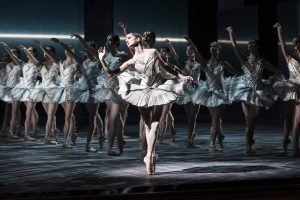Copenhagen and Malmö: Fall 2017 - Vancouver Ballet Society
- Home
- City Reports 2015 - 2019
- Copenhagen and Malmö: Fall 2017

by Anne-Marie Elmby
A 10-year-long wish came true for artistic director Nikolaj Hübbe when he succeeded in getting George Balanchine’s complete three-part Jewels (1967) on the stage for the Royal Danish Ballet. A window in a jeweller’s shop in New York inspired Mr. B to create the ballet, and the Royal Danish dancers sparkled in Karinska’s jewel-adorned green, red and white costume designs.
Gabriel Fauré’s melodious music offered fine accompaniment to Susanne Grinder’s Romantic adagio solo in the first part, Emeralds, as well as for her long stride on pointe at the hand of the gallant Marcin Kupinski.
Rubies had J’aime Crandall and Jón Axel Fransson celebrating the jazzy humour of Stravinsky’s Piano Concerto, while the statuesque Astrid Elbo was manipulated into impeccable high extensions by four gentlemen. In the second cast, Ida Praetorius’ swirling hips made the rubies on her skirt jingle, and her playful partner, Jonathan Chmelensky, due to special circumstances one evening, mastered the different styles of both Emeralds and Rubies.
With Tchaikovsky’s music for Diamonds, Balanchine epitomized his imperial mother country, Russia. It suited Holly Jean Dorger’s regal stature in her ideal partnership with Gregory Dean. The second cast had an adorable Caroline Baldwin in wonderful phrasing with Ulrik Birkkjær, who on May 19 danced his last performance with the Royal Danish Ballet, which has been his home base since he entered its school 25 years ago. A standing ovation assured him that he will be dearly missed. Starting next season, he will be joining San Francisco Ballet.
An extra farewell to Birkkjær occurred on June 3 at the Malmö Opera in Sweden, a half-hour drive across the bridge from Copenhagen. Together with Grinder, he had been called in to perform the Dance of the Hours intermezzo in Act III of Amilcare Ponchielli’s opera, La Gioconda. In spite of the very limited space left by the scenography, the Danish dancers’ performance in Tim Matiakis’ virtuoso choreography, with many intricate lifts, triggered bravos from the audience.
At the end of May, Malmö Opera hosted a visit by the Royal Swedish Ballet in Pär Isberg’s The Dream of Swan Lake, which had opened in Stockholm in April. The company already has Natalia Conus’ traditional Swan Lake and Mats Ek’s version, originally created for Cullberg Ballet, in the repertoire. Still, artistic director Johannes Öhmann wanted a third Swan Lake, and Isberg puts a fresh angle to the story.
In his version, a choreographer dreams of creating a new Swan Lake and spots a new talent to cast as his swan princess. There is also a theatre director, with a satirically portrayed entourage, whose attitude hints at a previous affair with the premier danseur, who is enraged when he is only cast for the part of Rothbart. In Act II, the choreographer’s vision for the ballet takes shape. He himself takes the role of Prince Siegfried, and falls in love with his Odette/Odile. When Rothbart appears, the young ballerina is torn between the two men, both in her role within the ballet and as a woman.
In a few places, Isberg changed sections of Tchaikovsky’s score around to suit his purpose, which was only noticeable if one knew the score extremely well. Overall, he has successfully amalgamated the original choreography with new material of his own, and he deserves credit for making the familiar Swan Lake drama work within a new delineation of the characters.
On May 28, Calum Lowden danced the choreographer with pensive emotion, and Nadja Sellrup showed fine development in her journey from insecure apprentice to full-grown swan and woman, who makes her own decisions. As Rothbart, Vahe Martirosyan had a demonic streak in his temperamental outbursts, and as the theatre director Jenny Nilson conveyed sarcasm through her whole stance.
As part of the annual Jewish Culture Festival in Copenhagen, the 20-year-old Compas Dance Company from Israel visited with their flamenco ballet, King David and Bat Sheba, choreographed by artistic director Mijal Natan. This story from the Old Testament was well suited to the sensual style of flamenco. Natan’s supple body language portrayed the female protagonist with initial evasiveness, but eventually yielding to her king. As the wilful King David, who insists on pursuing his passion, Spanish dancer Miguel Angel demonstrated a strong stage presence in his intense solos. Their duets had an appealing, balletic character. Ten dancers supported them in minor roles and formed a virtuoso corps in colourful costumes.
On June 11, Dance Science Denmark held its first symposium at the Royal Danish Theatre. The association is founded by physiotherapists and ballet teachers from the Royal Danish Ballet and Tivoli Ballet School. Treatment and recovery of dancers’ injuries was the main subject. Other issues concerning medical and scientific aspects of dance will be addressed in future.

Photo: Carl Thorborg
